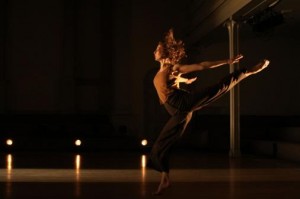Kyle Abraham’s skill at picking dancers is as great as his talent for choreography. During the 75 minutes that The Radio Show tickled our senses at REDCAT on Oct. 21, the audience was treated to bodily perfection. It was a combination, of course, of gracefully rhythmic movements, subtly seductive outfits and bodies that boasted sculpted lines and alluring curves.
From first sight, the costumes piqued our interest and set the sensual tone. Like Academy Award winners for Best Costume Design Chariots of Fire (1981) and Gandhi (1983), The Radio Show wasn’t showy in its designs, but it still scored big. The pants and tops in shades of brown and gold appear rather plain-looking. Yet it’s the way they hug the dancers’ torsos and limbs, and their backs peek out of the gaping holes intentionally cut to showcase the soft, sinewy lines. In modern times when it seems as if we need so much to stimulate us, Abraham reminds us how surprisingly erotic an oft-overlooked body part can be.
What’s even more attractive than the coyly exhibitionist style of the clothes is the egalitarian nature of the audience’s desire. Men and women admire both male and female. It’s a dual sexuality that transmits back and forth between the standing and the seated. The female dancers are as imposing as the male, the men as elegant as the women. The seductive ambivalence throws everybody in the same boat, leveling the playing field and making each solo, duet and group performance an exhilarating, power-shifting balancing act.
Using the dancers’ bodies as his Etch A Sketch, Abraham weaves his feelings, surrounding the closing of a popular black radio station in his hometown of Pittsburgh and Alzheimer’s in his own family, into the movements that power the performance. From the beginning, as Abraham himself walks through the crowd, his arm twitching uncontrollably, it appears as if some form of expression is being repressed. Later in the piece, when he tries to scream but no voice comes out, the disconnect and loss are even more obvious.
Playing on the theme of a black radio station, the soundtrack to the show sings with old and new popular tunes from Betty Wright to Mary J. Blige, Bill Withers to Beyoncé. It’s an interesting move when choreographers choose to use familiar tunes. They run the risk of the nostalgia factor. The audience has its own memories attached to the tunes, and the songs are usually associated with a certain time. But Abraham also accepts the challenge of taking the audience somewhere they’ve never been before. His work does just that, existing within the terms of the music but also pushing beyond, fusing hip-hop, ballet, street jazz and modern into something fresh.
Complementing the choreography are the seven dancers (including Abrahams) who truly inhabit each step. They are longtime friends of the beat, and their relationship blossoms over the course of the show. The second act overflows with funk, as each member of the motley crew adds its own flavor to the joyous mix. These dancers are having fun, which can be felt throughout and continues even after the performers take their bow, at which point they break out into playful party moves as they exit the stage.
Abraham doesn’t completely rely on the familiar. One of his more surprising moves is toward the end, when Antony Hegarty’s operatic version of Beyoncé’s “Crazy in Love” lulls the crowd, turning a smash pop ditty into a tender, albeit grating, aria. It’s only fitting that Abraham once again turns convention on its head.
—Jessica Koslow, Culture Spot LA







Trackbacks/Pingbacks